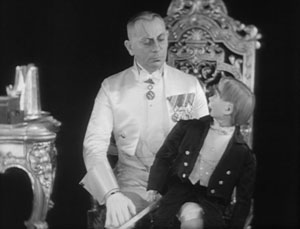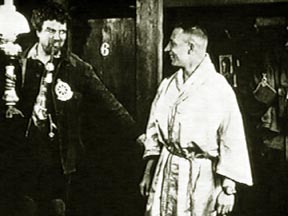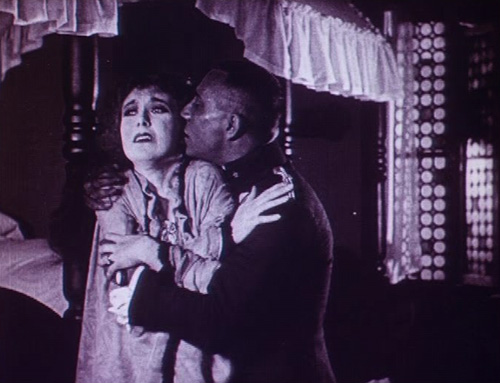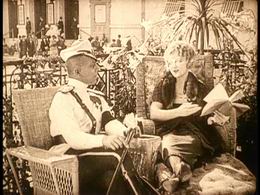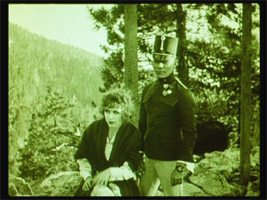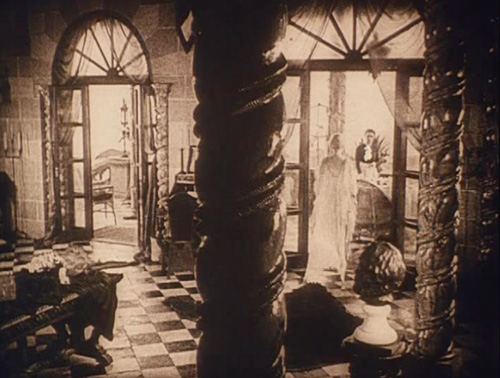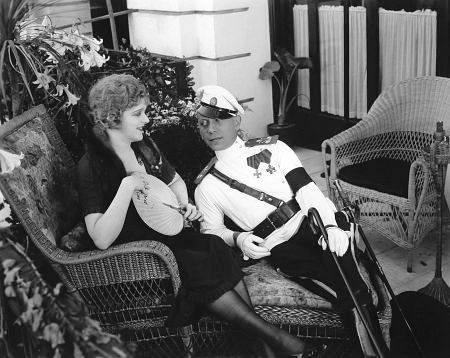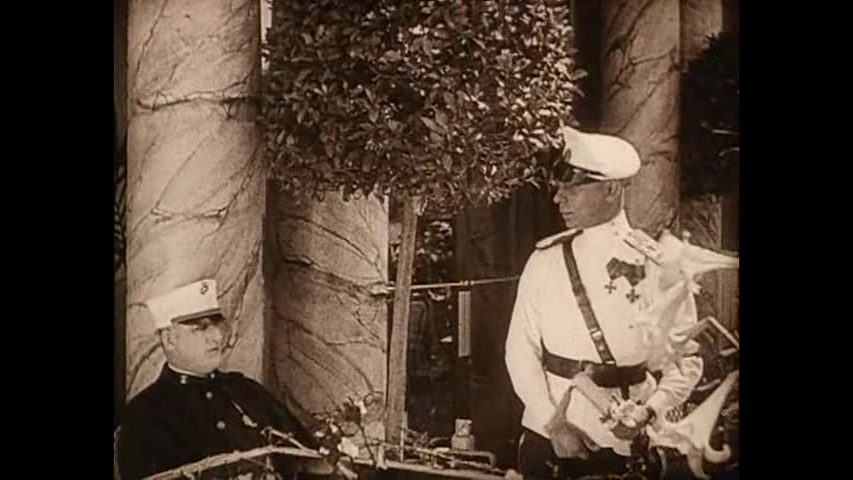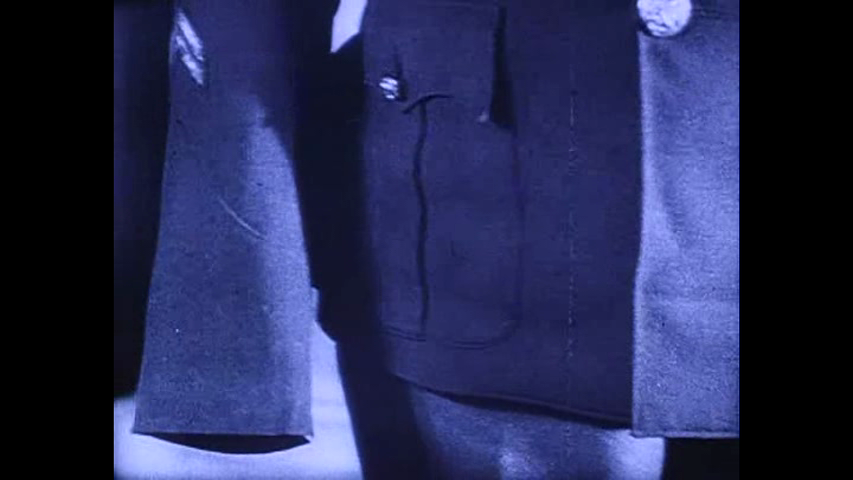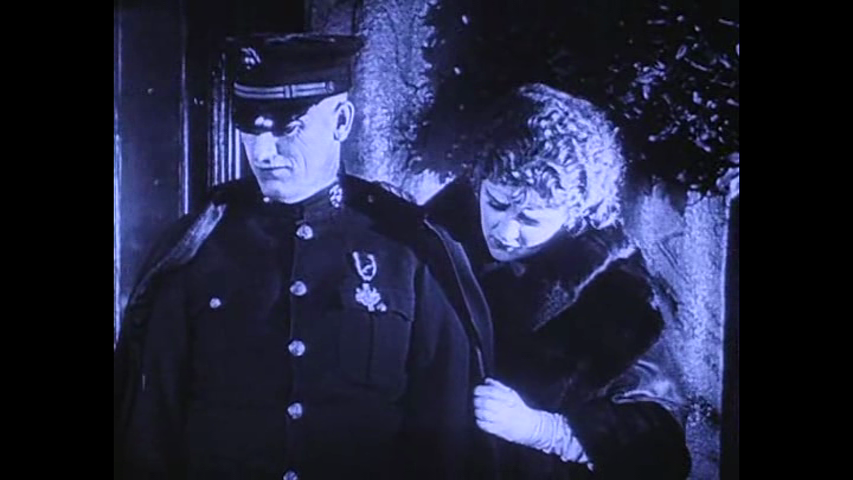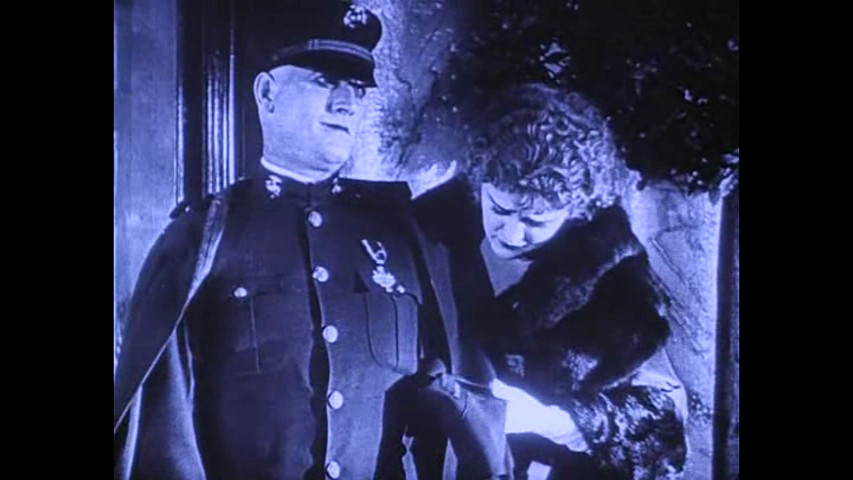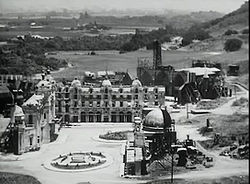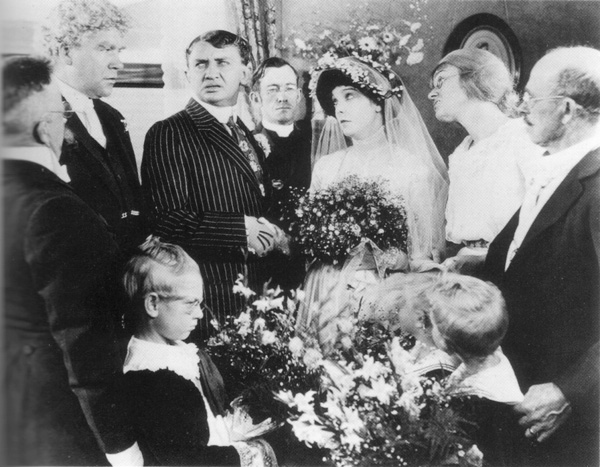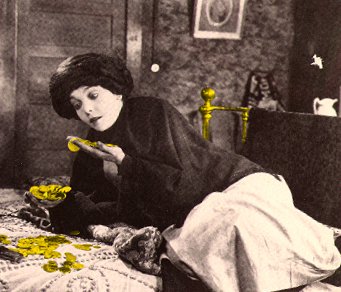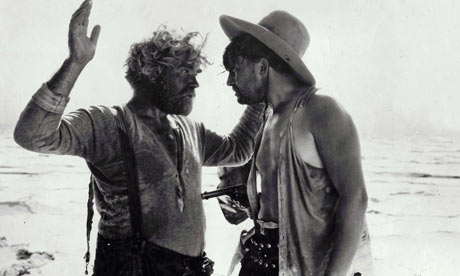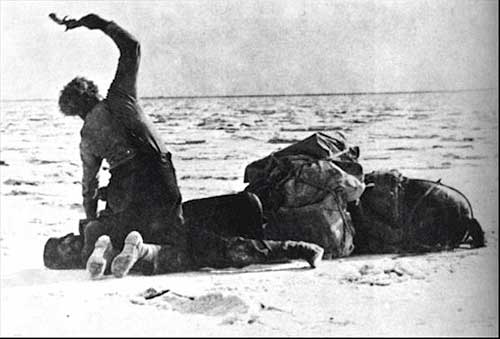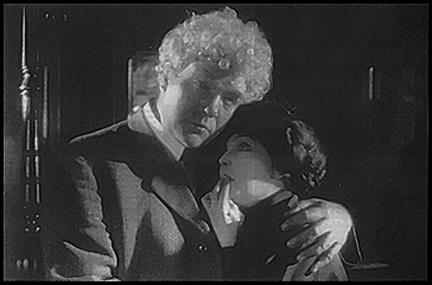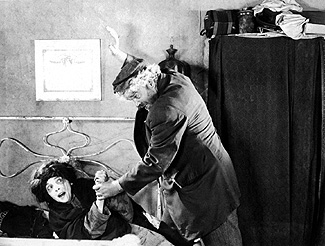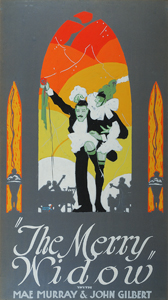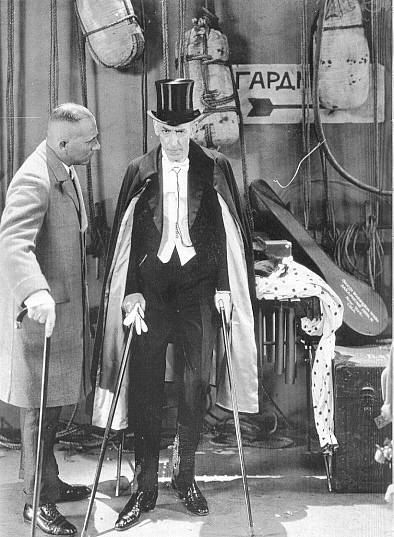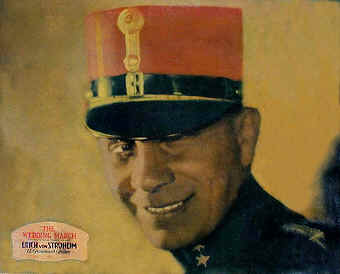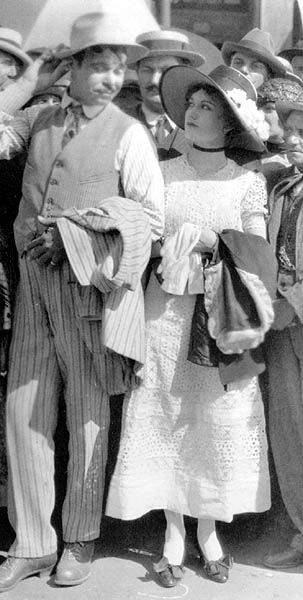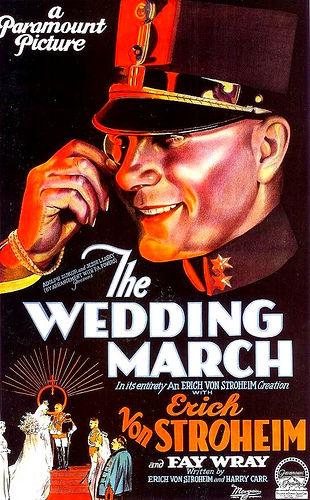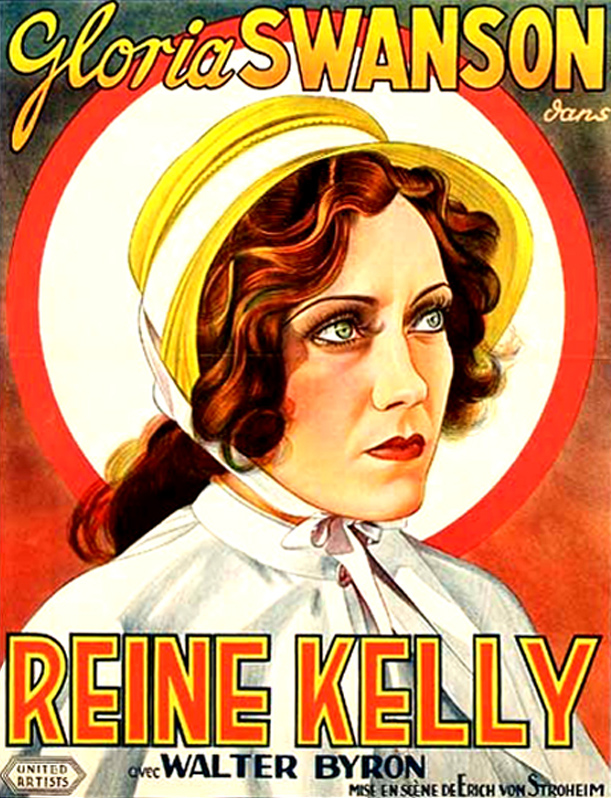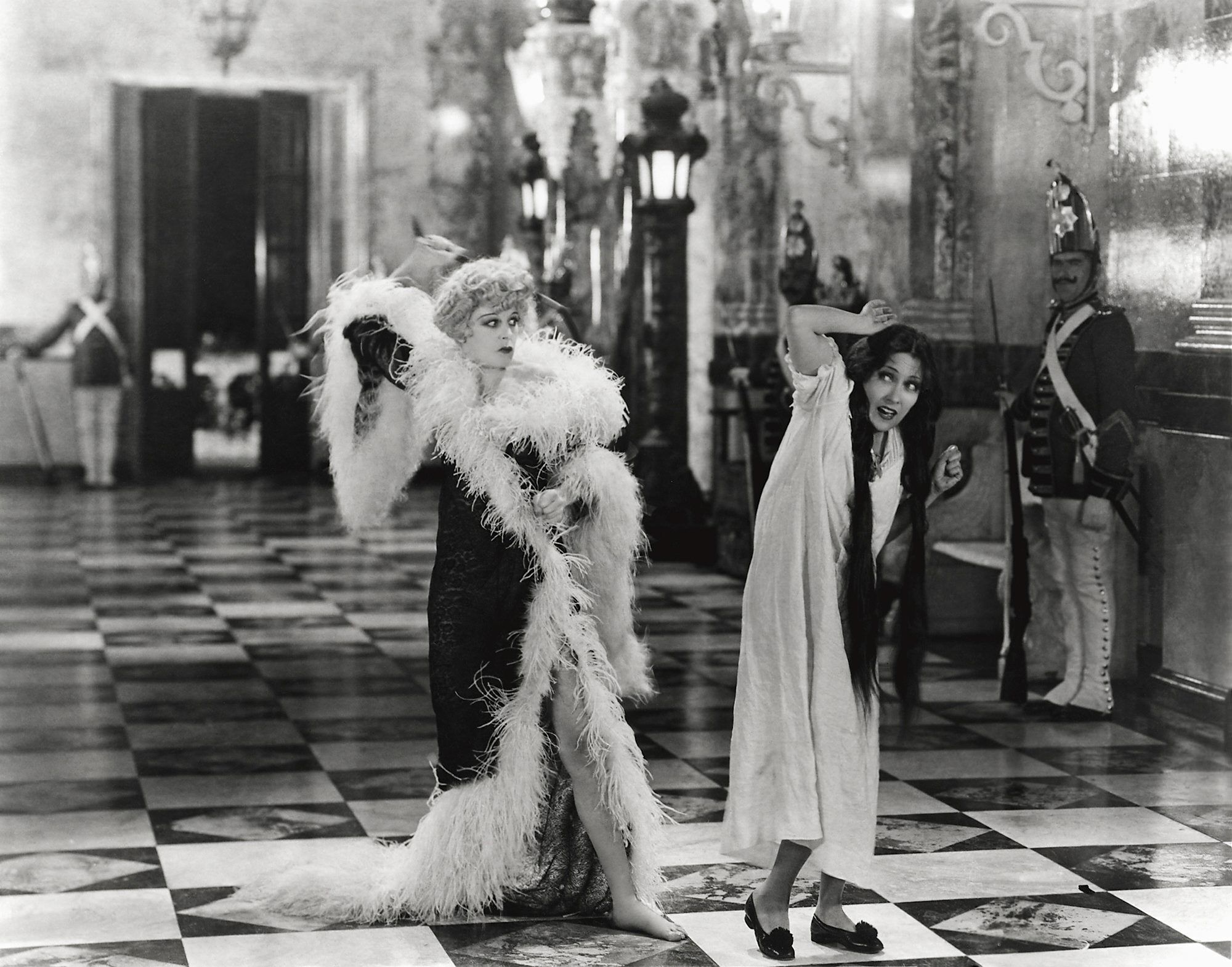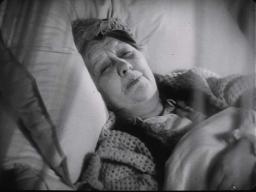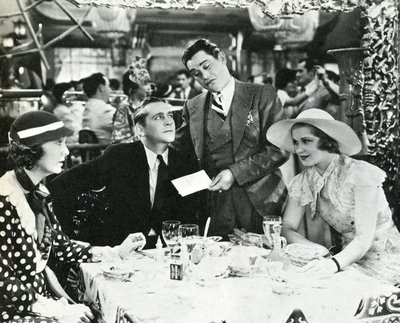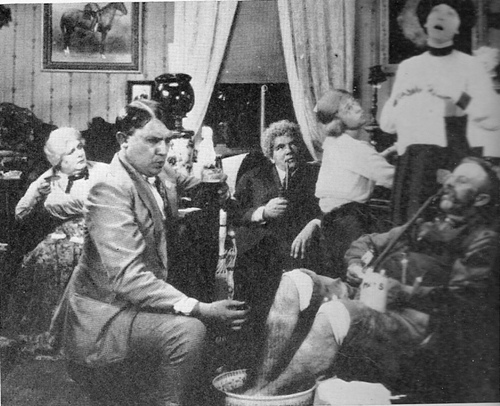This appeared as the lead article in the May-June 1974 issue of Film Comment — a somewhat pared-down revamping of my entry about Stroheim for Richard Roud’s belatedly published Cinema: A Critical Dictionary (New York: The Viking Press, 1980), and, if memory serves, the longest of my several contributions to that long out-of-print collection. — J.R.
Second Thoughts on Stroheim
by Jonathan Rosenbaum
Preface
Total object, complete with missing parts,
instead of partial object. Question of degree.
— Samuel Beckett, “Three Dialogues”
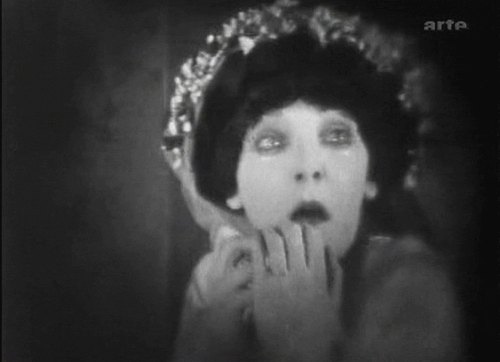
Two temptations present themselves to any modern reappraisal of Erich von Stroheim’s work; one of them is fatal, the other all but impossible to act upon. The fatal temptation would be to concentrate on the offscreen image and legend of Stroheim to the point of ignoring central facts about the films themselves: an approach that has unhappily characterized most critical work on Stroheim to date. On the other hand, one is tempted to look at nothing but the films — to suppress biography, anecdotes, newspaper reviews, reminiscences, and everything else that isn’t plainly visible on the screen.
Submitting Stroheim’s work to a purely formal analysis and strict textural reading of what is there — as opposed to what isn’t, or might, or would or could or should have been there — may sound like an obvious and sensible project; but apparently no one has ever tried it, and there is some reason to doubt whether anyone ever will. Over the past fifty-odd years, the legend of Stroheirn has cast so distinctive a shadow over the commercial cinema in general and his own work in particular that the removal of that shadow would amount to nothing less than a total skin graft; above all, it would mean eliminating the grid through which his films were seen in their own time — a time that, in many crucial respects, remains our own.
From one point of view, Stroheim’s films only dramatize problems of directorial control and intention that are relevant to most Hollywood films. They dramatize these problems, however, in a particularly revealing way: we remember his best works (FOOLISH WIVES, GREED, THE WEDDING MARCH, QUEEN KELLY) not merely because of their power — which is considerable — but also because of their will to power, which is always even more considerable. We are constantly brought up against the problem of considering his films as indications and abbreviations of projected meta-films that were either reduced and re-edited by the studios or, in the case of QUEEN KELLY, never completed in any form.
It is central to Stroheim’s reputation that he is valued today more for the unseen forty-two-reel version of GREED than the ten-reel version that we do have. And if history and legend have conspired to install Stroheim as an exemplary figure in cinema — virtually the patron saint of all directors who have suffered at the hands of producers — it is precisely because of this discrepancy, the gap between the power and control that was sought and the amount that was visibly achieved.
How are we made aware of this discrepancy? Certainly we sense it almost as much in Stroheim’s acting in the films of others as in his own projects — not simply because of all the dictatorial parts, from Prussian officers to assorted lunatics, but in the very style of his delivery, the very manner of his presence. Consider the sublime and all-but-hallucinatory tedium of his first role in a sound film, James Cruze’s THE GREAT GABBO, when he seems to speak each line at roughly half the speed of everyone else in the cast; here one can witness the will to power in a strictly temporal arena — the apparent desire to remain on the screen as long as possible — lending to the part of the mad ventriloquist an intolerable tension and demonic mulishness that go well beyond the melodramatic demands of the plot, as though he were pulling at his character like taffy to see how far it could stretch before breaking. Insofar as a single performance can be compared to an entire film, it is likely that the duration of the original version of GREED was motivated along similar lines.
The opening credits of GREED, THE MERRY WIDOW, and THE WEDDING MARCH alert us to Stroheim’s aspirations before anything else appears on the screen: the first two are said to be “personally directed by Erich von Stroheim,” the third is labeled “in its entirety an Erich von Stroheim creation.” But if accepting Stroheim’s legend means submitting to a fiction — a supplement, in many cases, to the fictions that he filmed — denying it is tantamount to imposing another, alternate fiction. (However much we may ever learn about Stroheim, it’s highly unlikely that we’ll know enough to do away with fictions entirely.) Bearing this in mind, an attempt will be made here to isolate his legend whenever possible, but not to dismantle it.
1
It is bad for man to believe he is more almighty than mountains.
— Sepp (Gibson Gowland) in BLIND HUSBANDS
Some favorite devices, recurring frequently throughout Stroheim’s work: a long shot dissolving into a medium shot of the same character, a camera movement that turns a medium shot into a close-up, and an upward or downward pan taking in the whole body of a character. Each represents a different way of taking a closer look at someone — the first usually introduces characters, the second permits an increasing concentration of dramatic focus and detail (like the extraordinary track up to the face of Dale Fuller, the exploited maid in FOOLISH WIVES, where we’re enabled to see revenge being hatched in her eyes), and the third is more in the nature of an inventory.
Eyes have an unusual authority in Stroheim’s films, and what is frequently meant by his “control of detail” is his uncanny gift for conveying information through an actor’s eye movements. How someone looks and sees is always a central character trait, and the story of each film is partially told in glances.
A memorable example occurs as one of the privileged camera movements in THE WEDDING MARCH, when Mitzi (Fay Wray), standing in a crowd, looks up at Prince Niki (Stroheim) sitting on a horse, and an upward pan gives us her exalted estimation of him. We can trace this shot all the way back to BLIND HUSBANDS, Stroheim’s first film (1918), when Erich von Steuban (Stroheim) first encounters “Silent Sepp,” the local Tyrolean mountain guide. Each sizes up the other in a separate pan: Steuban looks at Sepp, a slow pan from feet to head; Sepp looks at Steuban, a slow pan from head to feet. The central metaphysical conceit of the plot is hung on these two camera movements. Significantly, they are repeated in different but related contexts near the end: a slow pan all the way up the mountain on which the climactic struggle will take place, introduced as “The Pinnacle” (Stroheim’s own original title for BLIND HUSBANDS) and which Dr. Armstrong (Sam de Grasse) and Steuban are about to ascend; and in the midst of this struggle, while Armstrong stands over Steuban, clenching him by the throat — a slow pan from Steuban down the mountain to the rescue party of soldiers and others, including Sepp, making their way up.
From top to bottom, from bottom to top: thematically and dramatically, all of Stroheim’s films refer to this basic pattern. BLIND HUSBANDS provides at best only a rough sketch of what is to follow, but the essential lines are already there. Sepp is the pinnacle, the higher aspiration, and also something of a dumb-ox innocent, earthy and inert, who prevents Steuban from seducing Mrs. Armstrong (Francelina Billington) by appearing in the hotel corridor at just the right moment. (A cryptic monk appearing out of a rain storm in FOOLISH WIVES functions identically.) Steuban is the depths, the lower aspiration, the grim, deadly, and well-dressed seducer, full of bluff and pretension. In between stand the Armstrongs, an American couple, naive without being simple or wise (like Sepp), adventurous without being irresponsible or pretentious (like Steuban)–two free-floating characters who are, by extension, ourselves: likable zeros susceptible to the influences of a Sepp or a Steuban.
These and several other characters in BLIND HUSBANDS represent archetypes traceable back to the nineteenth-century novel. The credits indirectly acknowledge this heritage by claiming that the film is derived “from the book The Pinnacle by Erich von Stroheim,” an apparently imaginary work that no visible research has ever uncovered — much like the book Foolish Wives that the heroine of that film is shown reading [see above]. If the “realist” tag assigned to Stroheim often seems today like an outdated literary category — and one that might make Stroheim seem more outdated than he actually is — this is equally the case with his first literary models, Zola and Norris. The fictional worlds of all three are so charged with metaphysical forces and intimations of fatality that the “realism” they project is not one in which free will predominates; characters are usually doomed to be what they are by class and social position, heredity, mysterious turns of fate, or some malign combination of all three.
Steuban and the Armstrong couple can easily be seen as first drafts of Karamzin and the Hughes couple in FOOLISH WIVES — an elaborated remake in many respects. (THE DEVIL’S PASSKEY, made during the interval between the two, is a lost film today, but existing synopses indicate it to be another version of the same plot, which remained with Stroheim for years: Stroheim completed a new script based on BLIND HUSBANDS in 1930, which he planned to film in sound and color.) But the distance traversed between Stroheim’s first and third film is cosmic, even though only three years separate them. Vaguely sketched essences of character and locale became “three-dimensional” embodiments — not merely ideas expressed, but ideas incarnated — and we leap from an apprentice work to something closely approximating a mature style.
2
They are showing only the skeleton of my dead child.
— Stroheim after the release of FOOLISH WIVES
Comparing the Italian and American prints of FOOLISH WIVES in Cahiers du cinéma no. 79, Jacques Rivette observed that they differ not only by length, order of sequences, and editing within scenes, but also by the fact that they don’t always have identical takes of the same shots. He offers the very plausible hypothesis that the longer Italian version corresponds much more closely to Stroheim’s, while the American print is the version recut by Universal after the film’s New York premiere. It seems quite possible — I haven’t seen the American print in a few years — that the remarkable close-up of Dale Fuller’s storytelling eyes and the fire-firetruck montage, as described here, exist only in the Italian version.
A particularly troubling problem with both versions is the absence of what must be considered the film’s climactic sequences: the rape of Ventucci’s half-witted daughter (Malvine Polo) by Karamzin — or “Karamazin,” according to Thomas Quinn Curtiss — resulting in the murder of Karamzin by Ventucci (Cesare Gravina); and after Ventucci’s depositing of Karamzin’s body in a sewer (visible in both versions), the corpse shown at dawn in the midst of garbage floating out to sea; and Mrs. Hughes giving premature birth to a child, which brings about a reconciliation with her husband. (These scenes are all indicated in Stroheim’s synopsis.) Lacking these scenes, our understanding of Karamzin’s function in the film remains incomplete. Unless we can see the contrast between his magisterial first appearance by the Mediterranean and his exit as “rubbish” in the same setting, the trajectory of his scurrilous career is not fully articulated. And without the birth of the Hughes’s child — apparently suggesting a quasi-mystical resurgence of life out of the ashes of corruption — his death fails to achieve the proper resonance. But despite these and other regrettable lacunae, Karamzin remains Stroheim’s most complex and fascinating character outside of GREED, and provides the occasion for his definitive performance.
The differences between Karamzin and Erich von Steuban are so closely related to the differences between Stroheim’s authority as a director in each film that it is difficult not to see both characters as partial autobiographical counterparts. Karamzin displays all the low traits of Steuban, from vanity to cowardice, but two crucial characteristics are added: he is an impostor; and he is mainly out for money. Moreover, he is something of a professional con man while Steuban is at best a promising novice in the arts of deception, too often a fumbler to convince us that he is truly malignant. Both characters are identified with an “artistic” sensibility: one of Steuban’s ploys with Mrs. Armstrong is to play soulfully on the violin along with her piano, while FOOLISH WIVES invites us to relish Karamzin’s more subtle methods of enticement, delight in his grander fabrications.
A classic instance of Stroheim as trickster: the episode of the armless veteran. Already, in contrast to BLIND HUSBANDS, he is firmly establishing a very specific milieu and period in which to locate his story — Monte Carlo just after the War, where veterans on crutches and kids playing soldiers (some of whom seem to mock and “see through” Karamzin’s postures) form an essential part of the background. Because we don’t realize that the stolid man who, early in the film, neglects to pick up Mrs. Hughes’s gloves is armless, we assume that he’s around merely to indicate the kind of courtesy that she’s accustomed to receiving, and to provide Karamzin with an opportunity to display his own gallantry. The second time the man appears, exhibiting similar behavior in an elevator, we might imagine him to represent some sort of running gag. Then, when we discover he is armless, we are brought up short, and moved to pity: a strong ironic point has been scored. But Stroheim refuses to stop there. As Mrs. Hughes proceeds to fondle and caress one of the veteran’s armless sleeves, pity quickly turns into disquieting morbidity, and what we’ve previously been led to ignore we’re now obliged to dwell upon. In a brief instant that illuminates the rest of the film, comedy turns into tragedy and the tragedy becomes a fetish. It is a remarkable transformation of tone, created throughout by a series of false narrative expectations….If BLIND HUSBANDS squats somewhere uncomfortably between a “symbolic” play and a cheap novella, FOOLISH WIVES all but invents the novelistic cinema.
How does FOOLISH WIVES resemble a nineteenth-century novel? By turning the spectacle of Griffith into an analysis of social and psychological textures — Monte Carlo was his INTOLERANCE set -— Stroheim asks us to move around in his frames and episodes in a way that grants us some of the freedom and leisure of a reader’s experience. Griffith’s suspense montage has enough Kuleshovian (and Pavlovian) effects to deny the spectator the opportunity to use much of his intelligence. This creates momentum, to be sure, but Stroheim usually sweeps the spectator along with a different kind of persuasion. Griffith either lulls or harasses you into the role of just plain folks; Stroheim starts with the assumption that you’re witty, discerning, and twice as sophisticated as the fellow sitting next to you. Karamzin may be a sneak fooling that American ambassador and his wife with his phony credentials, but he doesn’t fool us.
We hate him because he is evil; we love him because we know him: that’s probably why we love to hate him. Stroheim loves to hate him too; it is something he is sharing with us as much as showing us. It is a very strange process: what the actor creates, the filmmaker annihilates and the portrait is as merciless as the character. He is confidential about what he shows us, like a novelist; he tells us the kind of things that are going on behind closed doors, when certain people are out of earshot. He wins our confidence by telling us secrets.
3
I had graduated from the D.W Griffith school of filmmaking and intended to go the Master one better as regards film realism. In real cities, not corners of them designed by Cedric Gibbons or Richard Days, but in real tree-bordered boulevards, with real streetcars, buses and automobiles, through real winding alleys, with real dirt and foulness, in the gutters as well as in real castles and palaces….I believed audiences were ready to witness real drama and real tragedy; as it happens every day in every land; real love and real hatred of real men and women who were proud of their passions.
— Stroheim, date unknown
It is witty for Godard to suggest that Méliès made documentaries, and rewarding to look at Feuillade’s films under that aspect; but Stroheim turned the fiction film into the documentary in a much more central and decisive way. He did this above all in GREED, and not so much through “stripping away artifice” as by reformulating the nature that his artifice was to take.
This was not simply a matter of shooting GREED on locations. More crucially, it was a direct confrontation with the challenge of adapting a literary work. McTeague is a work of fiction that impressed Stroheim and his contemporaries for its “realism”; by attempting to arrive at an equivalent to this literary mode, Stroheim wound up having to deal exhaustively with all of the essential problems inherent in adapting any fictional prose work.
There was certainly no filmmaker prior to Stroheim who attacked these problems in quite so comprehensive a manner, and it is arguable whether there has been anyone else since. For this reason alone, GREED remains a laboratory experiment of the first importance — valuable for its failures as well as its successes, and comprising a virtual textbook on some of the formal issues that it raises.
When Stroheim filmed GREED, Kenneth Rexroth tells us in the Signet edition of Norris’s novel, “he is said to have followed McTeague page by page, never missing a paragraph. We’ll never know because the uncut GREED, greatest of all movies, is lost forever.” To understand the important aspects of Stroheim’s adaptation, the first step is to dismiss hyperbole of this sort and work with the materials available: the novel, Stroheim’s screenplay (2), the version Of GREED that we do have, and the existing stills of scenes that were cut from the film.
The first thing that the published script tells us is that an enormous amount of material has been added to the novel, particularly in the opening scenes. About sixty pages — nearly one-fifth of the screenplay — pass before we reach Mc Teague eating his Sunday dinner at the car conductors’ coffee joint, the subject of Norris’s first sentence. Mac’s life prior to his arrival in San Francisco is conveyed by Norris in a brief resume of two paragraphs; in the script it consumes twenty-five pages. A brilliantly designed sequence that runs even longer, and is completely missing from the final version of the film, introduces us to all of the major characters on a “typical” Saturday afternoon that precedes the novel’s opening.
Interestingly, this sequence is largely constructed around cross-cutting between characters whose inter- relations in the plot have not yet become clarified — and in the case of Mac and Trina, between characters who have not yet even met — so that the juxtapositions are unusually abstract, even from a thematic point of view. As an approach to narrative that was already common to prose fiction but far from being a convention in cinema, this is probably the most “advanced” and experimental departure in the script: nearly everything that takes place is descriptive and inconsequential as plot, and each character is linked into an overall pattern of significance that nothing in the story has yet justified. Harry Carr, one of the only people who saw GREED in its complete form, may have had this sequence partially in mind when he compared the film to Les Miserables and remarked that “Episodes come along that you think have no bearing on the story, then twelve or fourteen reels later, it hits you with a crash.” (Motion Picture Magazine, April 1924.)
Undoubtedly the most problematical element in Stroheim’s adaptation is its use of repeated symbolic motifs — shots of gold, greedy hands, animals and other emblems — which seem to be a direct misapplication of literary principles to cinematic structures. The recurrent image in McTeague of Mac’s canary “chittering in its little gilt prison” — a phrase repeated with slight variations in many contexts, before it appears as the final words in the novel — works symbolically and “musically” because it is laced smoothly into the thread of the narrative, with no breaks in discourse or syntax. But in GREED, the repeated images have the disadvantage of interrupting the narrative, usually without adding any useful perspectives to it: they are like footnotes that mainly say “Ibid.” In their limited use in the film that we have and their implied use in the script, they tend to seem like dead wood clinging to the rest of the film.
The script further leads us to suspect that many of the motifs are repeated without variation — like the mother rocking the cradle in INTOLERANCE — and occasionally without any naturalistic explanation, like the shot of wood being sawed, which recurs no less than eight times during the wedding sequence. Such a shot is a purely abstract intrusion, but not one that serves to expand the narrative; like Tolstoy’s historical arguments in War and Peace, it seeks to contract the total picture into a graspable, didactic design. And it fails, one can argue, for roughly the same reason that Tolstoy fails -— because Stroheim has more to show than he has to say. The world he creates in the wedding sequence alone overwhelms anything he has to say about it: it is too rich to accommodate supplementary lessons.
Which brings us back to the “realism,” the documentary aspect of GREED. Clearly one of its most extraordinary aspects remains the unusual conviction of the performances, which is apparent even in the random instants offered by stills. Look at any frame enlargement from GREED showing ZaSu Pitts, Gibson Gowland or Jean Hersholt and you’ll see not a familiar actor “playing a part,” but a fully rounded character existing — existing, as it were, between shots and sequences as well as within them (or such is the illusion). How many films in the history of acted cinema would pass this elementary litmus test? Certainly not CITIZEN KANE; perhaps THE MAGNIFICENT AMBERSONS, a film whose achievement (and mutilation) parallels that of GREED in many important respects. (1)
One recalls André Bazin’s famous remark about Stroheim: “In his films reality lays itself bare like a suspect confessing under the relentless examination of the commissioner of police. He has one simple rule for direction. Take a close look at the world, keep on doing so, and in the end it will lay bare for you allits cruelty and its ugliness. One could easily imagine as a matter of fact a film by Stroheim composed of a single shot as long-lasting and as closeup as you like.”
This is the spirit of documentary — a tendency that is equally present in Stroheim’s introduction of outside chance elements into his fictions. It’s not so much a matter of letting random accidents creep into the staged actions (as in Léonce Perret’s 1913 melodrama L’ENFANT DE PARIS, when a friendly dog wanders into a shot at the heels of an actor) as a sort of semi-organized psychodrama, exemplified in a scene missing from current prints of GREED: When Trina discovers Maria Macapa with her throat slit, she runs out of Zerkow’s junk house and hysterically reports the murder to the first people she sees. Stroheim shot this sequence with hidden cameras, and the responses came from passersby who were not aware that a film was being made. When Samuel Fuller used a similar technique at the beginning of THE CRIMSON KIMONO (1959) and Godard followed the hero of LE PETIT SOLDAT (1960) down the streets of Geneva holding a gun, they were drawing on a common principle that Stroheim had already made extensive use of thirty-five years ago.
IV
0 Love — without thee marriage is a savage mockery.
— opening title Of THE WEDDING MARCH
GREED stands at roughly the halfway point in Stroheim’s fifteen-year career as a director, constituting both a caesura and a change of direction in his oeuvre. Four features precede it and four follow it, and beneath the continuity of certain undeniable stylistic and thematic traits, Stroheim’s preoccupation with realism, his concern with narrative, and the nature of his ambition all undergo important transformations.
The first thing to be said about THE MERRY WIDOW, the film immediately following GREED, is that it represents a nearly total inversion of the former’s approach: after filming his least compromised, most -realistic” work, he promptly made a film that was his most compromised and least “realistic.” At its best, THE MERRY WIDOW has a lightness of touch and a grace of movement suggesting a presound musical, with an idealized fairy-tale landscape (clearly established in the opening shots) that necessitates a very different kind of discourse. The most striking offbeat elements in this Hollywood dream bubble — Prince Mirko (Roy D’Arcy) and Baron Sadoja (Tully Marshall) — figure in the overall scheme in a way that is analogous to the “marginal notations” of irreverence that characterize most of Buñuel’s films in the Fifties: they offer ironic swipes at the conventional aspects of the material without ever seriously threatening the root assumptions of these conventions.
Prince Mirko is an obvious derivation of Erich von Steuban and Count Karamzin, but his role here is not as central: as a foil to the romantic figure of Prince Danilo (John Gilbert), he can not wield the same kind of lethal authority. Similarly, the more grotesque part of Baron Sadoja — a “first draft,” as it were, of the even more monstrous Jan Vooyheid, incarnated by Tully Marshall in QUEEN KELLY — is allowed to function as a grim commentary on the action and an intrusion on the central love story, but at no point is he really permitted to dominate the film.
Regarding THE MERRY WIDOW as a transitional work, one can perhaps best understand Mirko and Sadoja not as ”realistic” intrusions — they are anything but that — but as rebellious counter-fantasies provoked by the more conventional fantasies embodied by Danilo and Sally O’Hara (Mae Murray). If the earlier films were an attempt to subvert Hollywood from an outsider’s position — eliminating the characteristic romantic leads, and in the case of GREED, literally moving out of the studios to locations — THE MERRY WIDOW announces the counter-strategy of boring from within. There is more than one prefiguration of this procedure in THE MERRY WIDOW. The most celebrated instance occurs in the theater, when Sadoja, Mirko and Danilo each look at the dancing heroine through opera glasses: the first concentrates on her feet, the second on her body, the third on her face.
Another noticeable shift in Stroheim’s style is a somewhat different use of durations in relation to narrative. In the silent films after GREED, despite Stroheim’s continued interest in making long films, the novelistic aspect becomes less important, and the ritualistic, ceremonial aspects of duration gradually come to the fore — the obsessive desire to keep looking at something not in order to “understand” or “decode” it, but in order to become totally absorbed in it, transfixed by it; not to penetrate the surfaces of things, but to revel in these surfaces. As suggested earlier, the aggressivess of Stroheim’s camera eye ultimately leads to a kind of passivity. In the films after GREED, this change becomes much more explicit. The belligerent eye of the skeptic gradually turns into the passive eye of the voyeur.
This generalization tends to oversimplify a great deal of Stroheim’s work, and probably shouldn’t be taken as literally as it is stated above; but it does help to account for the peculiarly dreamlike elongations of actions and scenes in THE MERRY WIDOW, THE WEDDING MARCH, and QUEEN KELLY. A simple comparison might help to clarity the difference: when the camera slowly approaches Dale Fuller’s face in FOOLISH WIVES to reveal the revenge plans being formed in her eyes, the lingering effect has a purely narrative function, permitting us to watch a process more clearly than we could otherwise. But when the camera slowly tracks up to the face of Mae Murray in her wedding dress, and then recedes a bit to frame her entire figure as she proceeds to tear up the dress, we are being asked to concentrate on her primarily as an object; the “process” at work is chiefly the camera movement itself. We can intuit that the character’s visible distress leads to her act of violence, but the steps leading from A to B are implied more than chronicled. They are the scene’s justification, but not its major focus.
Nor is it just a question of the relative lack of virtuosity in Murray’s performance. Gloria Swanson’s performance in QUEEN KELLY is quite adept in its development and exposition of motives. But this is no longer the camera’s primary subject: virtually all of the characters in Stroheim’s last silent films exist as essences, fixed points of reference — “static essentials,” to borrow Pavese’s phrase. That Stroheim intended to show Kelly undergoing a complete transformation — from innocent to brothel madam to queen — must be acknowledged, but the evidence of this change was not recorded on film; it isn’t until WALKING DOWN BROADWAY that we find a visible (if partial) throwback to a ”narrative performance” in the part of ZaSu Pitts as Millie.
THE MERRY WIDOW announces a more static view of action and character; THE WEDDING MARCH and QUEEN KELLY, both epics of slow motion, expand and sustain it. It is hardly accidental that religious and military ceremonies figure so importantly in these films — they, too, are “static essentials.” The “realistic” impulse goes through no less pronounced a change: the European countries of THE MERRY WIDOW and QUEEN KELLY are fantasy kingdoms, and even the celebrated accuracy of detail in the Vienna Of THE WEDDING MARCH is subject to fanciful additions. “I am through with black cats and sewers,” Stroheim is reported to have said while making the film. “I am going to throw perfumed apple blossoms at the public until it chokes on them. If people won’t look upon life as it is, we must give them a gilded version.”
And a gilded version is what THE WEDDING MARCH (3) supplies. Even though the villain Schani (Matthew Betz), a pigsty and a slaughterhouse are all clearly intended to offset the apple blossoms, these supposedly “realistic” elements are just as idealized as the romantic ones. Next to Stroheim’s other villains, Schani is a crude cardboard cutout who is never allowed to expand beyond a few basic mannerisms (mainly spitting); and the other major characters — Prince Nicki (Stroheim), Mitzi (Fay Wray) and Cecelia (ZaSu Pitts) — are unusually simplistic creations for Stroheim.
One could be charitable (and many critics have been) by regarding the figures and themes of THE WEDDING MARCH as mythic distillations of their counterparts in previous Stroheim films; or one can be less charitable and regard them as inert calcifications — rigid prototypes whose original raison d’étre is lacking. THE WEDDING MARCH is generally accorded a high place in the Stroheim canon, and it must be admitted that it has a magisterial, “definitive” quality that is missing from most of his other work. But speaking from a minority viewpoint, I might argue that a certain price has to be paid for this rather self-conscious classicism. Apart from rare scenes-like the remarkably subtle exchange of looks and gestures between Nicki and Mitzi during the Corpus Christi procession, the action, characters, and symbolic motifs (e.g., the Iron Man) are so schematically laid out that they assume a certain thinness; investigation is consistently bypassed for the sake of a polished presentation, and the eighth time that we see Schani spit could just as functionally be the second time or the ninth.
Seen purely on its own terms, THE WEDDING MARCH is undeniably an impressive work. Offering us spectacle more than drama, it is a stunning display of lavishness and an ironic commentary on a particular kind of royal decay lurking underneath. It is only when we place it alongside FOOLISH WIVES, GREED, and QUEEN KELLY that we can understand its limitations. What these films (and even the others, to lesser degrees) possess that THE WEDDING MARCH lacks is an acute sense of transgression. And it is precisely this sense that makes QUEEN KELLY, for all its own limitations, a more pungent and exciting work. If THE WEDDING MARCH converts many of the familiar Stroheim themes into a series of dry homilies and mottoes, all suitable for immediate framing, QUEEN KELLY converts many of these same themes into a species of delirium — a possessed work of hypnotic, almost hallucinatory intensity. In contrast to the icy elegance of THE WEDDING MARCH, QUEEN KELLY breathes fire.
It is trashy, yes; but in the best sense, like Matthew G. Lewis’s The Monk and Faulkner’s Sanctuary. And at certain moments it achieves an elegance of its own, an elegance recalling that of a Nathanael West or a Georges Bataille, at least in stylistic control and continuity.
Which is not to praise QUEEN KELLY for its literary qualities: it has none, or at least no more than Stroheim’s novels like Paprika do. On the contrary, GREED and location work aside, it is the most “cinematic” of his films, the one most alive to the medium’s formal possibilities. The lighting is his most richly orchestrated, the camera moves about with an unprecedented freedom (assuming the hero’s angle of vision, for instance, as it scans the doors in the convent for Kelly’s room), and the use of duration has never been quite as operative as it becomes here. QUEEN KELLY is Stroheim uncensored — that is to say, more kinky, due to the effect and implications of the durations, than he probably ever intended it to be.
The unnatural protraction of the fireside seduction scene and (most particularly) the marriage of Kelly to Jan Vooyheid over the figurative and literal corpse of her aunt, would probably seem more sentimental and less carnal if they were trimmed down to conventional lengths. As they stand, they tend to create an emotional detachment in the spectator by making the actors and settings into purely aesthetic objects, delectable or abhorrent surfaces arranged in such a way that the possibilities of identifying with them or sentimentalizing them are decreased. Considering the increase in sentimentality in all of Stroheim’s films after GREED, this is rather a throwback to the dryer, more “scientific” style of his earlier period, but here it is exercised on a fictional world that is substantially more metaphysical and dreamlike, and less concerned with sociological and psychological matters. QUEEN KELLY is probably the closest thing in the Stroheim canon to an abstract work, a self-enclosed film that secretes its own laws. The sense of transgression that we experience in the previous films is always grounded in morality; here it seems to come to life as a direct expression of the id — as when Queen Regina (Seena Owen) beats Kelly with a whip across an enormous hall, down a grand flight of steps, and out the door of the palace — and morality mainly seems to figure in the action like the memory of a bad dream.
Unconsummated lust, a sustaining leitmotif throughout Stroheim’s work — a stale-mated struggle reflected in the pull between the nineteenth and twentieth-century aspects of his art — is finally stretched out into a slow-motion revery that is studied as if it were taking place under a microscope. Vooyheid is even literally seen as an insect, when he appears in the final marriage-and-death sequence comprising the recently discovered ”African footage: a scarred preying mantis on crutches, with a cigar in his teeth (or fist) and various objects sticking out of his pockets like additional legs, and a tongue that moves over his lips like a feeler.
He and Kelly stand on opposite sides of the aunt’s deathbed; a wedding veil is fashioned out of a bed awning by some local prostitutes. Intercut with close-ups of Kelly in tears are shots of the black priest — who, like her, is dressed in white from her viewpoint, blurring (to suggest tears) and then turning into an image of Prince Wolfram in white robes; another blur, and the Prince is in a black uniform; still another blur, and we return to the black priest in white. When her aunt expires, Kelly throws herself down on the body; the priest kneels; and then Vooyheid, who is kneeling, slowly raises himself on his crutches until he is the only figure standing.
As far as the silent cinema is concerned, this Manichaean spectacle constitutes Stroheim’s last rites: an arbitrary ending, perhaps– it was certainly not the one he had in mind for QUEEN KELLY-but an appropriately emblematic conclusion nevertheless. With the death of the aunt, we arrive at the imminent loss of innocence and the ascension to power of pure evil — a lurid ellipsis and a suspension of possibilities that were already rather explicit in BLIND HUSBANDS. But the “message” is no longer, ”Watch out for him!” It has become, simply, “Look at him!” And were it not for the somewhat problematical footnote provided by HELLO, SISTER!, one might say that Stroheim’s career as a director ends at roughly the same time that virtually all remaining pretense of free will vanishes from his imaginary kingdom.
Epilogue
Do you like funerals? I saw the cutest one last Saturday….I’m just a fool about funerals! — Millie (ZaSu Pitts) in HELLO, SISTER!
Even in its mutilated, garbled, and partially reshot form, HELLO, SISTER!, the release version Of WALKING DOWN BROADWAY, is recognizably Stroheim for a substantial part of its running time. (See the factual /speculative reports of Richard Koszarski in Sight and Sound, Autumn 1970, and Michel Ciment in Positif no. 131, Octobre 1971). The “final shooting script” Of WALKING DOWN BROADWAY — dated 8/9/32, assigning story and continuity to Stroheim, and dialogue to Stroheim, Leonard Spigelgass, and Geraldine Nomis — helps us to understand some of the original intentions, but also suggests that even in its original state it would have been a minor Stroheim work. The absence of certain audacities and eccentricities in the release version — which include Mac (Terrance Ray) on a dance floor “[holding] up his middle finger at Jimmy,” jokes about Prohibition, and various things relating to Millie (such as her pet turtle Lady Godiva and her dialogue with Miss Platt, a middle-aged hunchback) — are somewhat offset by various banalities that are also missing. The ending of the film that we have is a standard Hollywood clincher; but it is hardly much worse than the one prefigured in the script, in which ”Peggy and Jimmy walk close to show-window and look. Wax baby in Nurses’ arms — as before — except window is dressed for Easter.” Peggy says “(Motherly): Isn’t it cute?” Jimmy says “(Fatherly): Sure is!” And “They draw close together and look at each other admiringly.”
Much of the interest in HELLO, SISTER! today derives from the opportunity to see Stroheim recasting many of his most familiar procedures in the context of sound. The repetitious character trait that would have been expressed visually in THE WEDDING MARCH — e.g., Schani spitting — is conveyed here in the dialogue: Mac uses the phrase “Catch on?” nearly two dozen times in the script, much as Veronica (Françoise Lebrun) continually makes use of “un maximum” in Jean Eustache’s recent THE MOTHER AND THE WHORE. Elsewhere the dialogue often becomes less functional and tends to distract from the visuals. The Southern and New York accents of Peggy (Boots Mallory) and Jimmy (James Dunn) are important aspects of the characters, but their narrative function is not controlled in the way that the actors’ visual presences are. When Jimmy provokes Millie’s sexual jealousy in a scene near the end by refusing her help (”You’re all right, Millie — but you wouldn’t understand”), the extraordinary expressiveness of ZaSu Pitts’s reaction — the way her eyes flare up at his casual dismissal — is as striking as the close-up of Dale Fuller already alluded to in FOOLISH WIVES. (The relationship doesn’t stop there: both characters suffer from sexual rejection, and take revenge by starting fires which provoke the grand finales of both films.) But Pitts’s acting in this case becomes the subtext of the dialogue rather than vice versa, a classic instance of the way that sound films often teach spectators not to see; the mystery inherent in her character tends to be minimized by the “explicating” power of the dialogue, and what might have been twice as powerful in a silent context can easily escape attention here.
To some degree, the dialogue in HELLO, SISTER! only makes more explicit some of the schematic simplifications of character and situation that are constants in Stroheim’s work, negating some of the openness and the demands on the spectator’s imagination imposed by silence. In every silent Stroheim film but GREED, the sound of English or American voices invading the continental kingdoms would surely have worked as an alienating factor. HELLO, SISTER!, which relates back to GREED in many respects (Mac and Jimmy are derived from Mac and Marcus, and even a lottery figures comparably in the WALKING DOWN BROADWAY script), is set in New York, and doesn’t have to deal with this problem — indeed, the accents and inflections here are aids to verisimilitude-but at the same time, the screen is no longer quite the tabula rasa that it was, and the characteristic Stroheim Stare (the trained concentration of the camera on his fictional world) recedes somewhat under the verbiage, which frees us partially from the responsibility, of looking.
The major stylistic developments in Stroheim’s career took place between BLIND HUSBANDS and FOOLISH WIVES. One can speak of additional developments up through GREED, but after that one can principally refer only to certain simplifications and refinements. This is surely characteristic of Hollywood cinema in general, where Howard Hawks can devote a lifetime to refining FIG LEAVES and A GIRL IN EVERY PORT, and even a director as “experimental” as Hitchcock is periodically forced to retreat to the formulas of earlier successes. In the case of a maverick like Stroheim, the miracle–apart from his remarkable early development — is not that he wasn’t able to develop his style after GREED, but that he was able to make further films at all.
And in order to do so, he clearly had to pay a price. Whether or not future work in sound films would have led to other stylistic developments is impossible to determine; at best, all that HELLO, SISTER! suggests is the desire to accommodate his style to sound rather than to expand its basic options. Considering its relatively small budget, BLIND HUSBANDS can be seen as another sort of accommodation; and in a sense the evidence of the best in HELLO, SISTER! is comparable. It marks Stroheim as a promising director.
***************
Notes
1. Consider the close relationship between Mac’s and Trina’s loss of the Dental Parlors and the ultimate fate of the Amberson mansion (and the accompanying scenes in each film); consider the use of a closing iris to seal off an era when the Sieppes depart on the train at the end of Part I of GREED, with the retreating horseless carriage in AMBERSONS. Even the “real” explosion of anger between Gowland and Hersholt in the last reel of GREED, is matched by Agnes Moorehead’s “real” hysteria as Aunt Fanny in a climactic scene Indeed, the primary contrast between these films (apart from the nearly two decades that separate them —- a period that corresponds quite precisely, eighteen years, to the time that passed between the first appearances of McTeague and the Tarkington novel) is in the respective economic and social classes they depict.
2. Originally published by the Cinémathèque de Belgique in 1958; a somewhat copy-edited version has recently been brought out by Lorrimer, edited by Joel W. Finler. Finler, who has kindly assisted me on much of my research, has informed me that he has subsequently seen another, presumably later version of the script at the Cinémathèque de Belgique, on the basis of a quick examination, Finler estimates that it this was the draft used by Stroheim as a shooting script, the film would have been roughly an hour shorter than the version prefigured in the published script.
3. Regrettably, the only portion of the film that can be considered here is the First Part, as edited by Stroheim for the Cinémathèque Française in 1954; the Second Part, THE HONEYMOON, was destroyed in a Cinémathèque fire, and apparently no other copies survive today.
— Film Comment, May-June 1974


